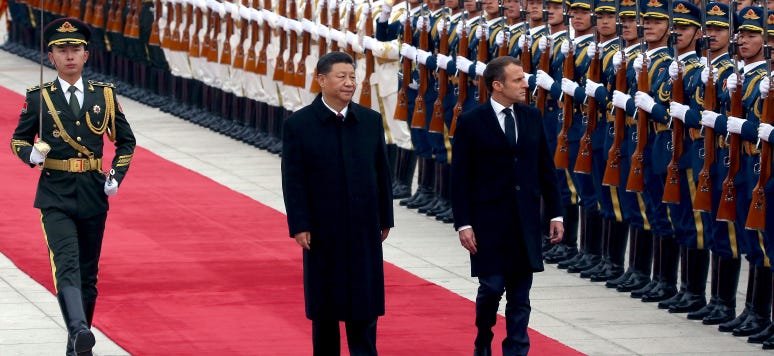Open Context
AI superstar Yang Zhilin, Macron in China, Shanghai fashion week, Lancang/Mekong "mother of waters", rewriting the Marcos years, USA wrote Australian defense review
UPDATE: In a report from Hong Kong, Sequoia’s China arm had quietly backed one of the most notable young AI researchers in the country, Yang Zhilin, a young assistant professor at Beijing’s prestigious Tsinghua University.
Macron is a much-liked figure among China’s Europe watchers. “Macron never rejects China in his grand strategy, but rather emphasises cooperation with the PRC,” write Wu Yiwen (武亦文) and Wang Shuo (王朔), two professors at Beijing Foreign Studies University.
The business lowdown on the emerging designers at the Shanghai shows with the potential for breakthrough beyond China. In post-lockdown China, a number of designers are emerging with considered business plans and a clear path to growth.
China and Southeast Asia’s Lancang/Mekong may be the most important river in the world. Known as the “mother of waters,” it is home to the world’s largest inland fishery, and the huge amounts of sediments it transports feed some of the planet’s most fertile farmlands. Tens of millions of people depend on it for their livelihoods.
The Marcos years are again the subject of heated debate because another Ferdinand Marcos, his son and namesake, was elected president last May, winning almost 59 per cent of the vote. He seems to have succeeded in creating a new narrative about his father’s rule and downfall.
The ‘Senior Advisor and Principal Author’ of Australia’s Defence Strategic Review is a Director of the United States Studies Centre. The Albanese government has stepped up its efforts to bolster US promotion of AUKUS and the Australian acquisition of nuclear-powered submarines (SSNs) and other US weapons systems.
US investments into China Keep Growing
It’s become a major refrain among several U.S. tech leaders that the U.S. can’t let China win in artificial intelligence. And so it is pretty interesting that leading venture firms funded by U.S. endowments and other institutional investors are putting money into the most promising young AI startups in China.
Last year’s CHIPS and Science Act said U.S. microchip companies that take government funding can’t make new investments in China. It’s not hard to imagine the US government seeking to cut funding to Chinese AI companies. AI, like chips, will undoubtedly be strategic to national interests. However, cutting off China, in chips or AI, will, over time, make China’s tech industry stronger. That means the best way to compete in chips, AI and everything else is to have better technology.
In a report from Hong Kong, Sequoia’s China arm had quietly backed one of the most notable young AI researchers in the country, Yang Zhilin, a young assistant professor at Beijing’s prestigious Tsinghua University.
Yang Zhilin is cofounder of Recurrent AI and an assistant professor of Tsinghua University.
The ultimate goal of his work, including both research and business, is to maximize the value of artificial intelligence. He and his team are working on achieving general cognitive intelligence using natural language as a key interface, i.e., human users interact with a machine using natural language for performing various cognitive tasks. They not only formulate and solve general research problems, but also build products and solutions. Zhilin believes breaking the barrier between research, engineering, and business is a crucial path towards the goal.
In 2019, he obtained my PhD degree from the School of Computer Science, Carnegie Mellon University, advised by Ruslan Salakhutdinov and William W. Cohen. In 2015, he received a bachelor's degree from Tsinghua University, advised by Jie Tang. Zhilin has worked at Meta AI with Jason Weston, and Google Brain with Quoc V. Le.
Zhilin is a Forbes Asia Under 30 awardee, an Nvidia Fellow, a Siebel Scholar, and a BAAI Young Scientist. His projects received the Nvidia Pioneering Research Award, the Facebook ParlAI Research Award, and the Yunfa Award at the World AI Conference.
Visit Zhilin Yang’s bio page here.
Download Zhilin Yang’s XLNet: Generalized Autoregressive Pretraining for Language Understanding here.
Download Zhilin Yang’s Learning to Detect Noisy Labels Using Model-Based Features here.
shanghai fashion week
The business lowdown on the emerging designers at the Shanghai shows with the potential for breakthrough beyond China. In post-lockdown China, a number of designers are emerging with considered business plans and a clear path to growth.
Lyu Xiaolei, secretary-general of Shanghai Fashion Week’s organising committee, says the challenges of the pandemic have motivated designers to structure their business more effectively: “During this time, some of these young designers have become more stable and mature in their exploration of business models and have gradually clarified their routes in terms of brand design positioning.”
The upbeat message is shared by Tasha Liu, co-founder of fashion incubator Labelhood. “Brands are still evolving because the market never stops. It’s the best teacher we have,” she says. I think we now have better quality brands with solid aesthetics that tell their story and more SKUs to show their designs.”
Here are some key names to watch:
Oude Waag, launched in 2018 by Chengdu-born Yin Jingwei, who studied at London’s Royal College of Art. His high-impact show at Shanghai Fashion Week, styled by Liu Xiao, chief fashion editor of Wallpaper China edition.
Staffonly, founded in 2015 by Shimo Zhou and Une Yea, delivered a whimsical, fun show for Autumn/Winter 2023 at Shanghai Fashion Week. Models walked lines inspired by planetary movements and bounced on a trampoline.
Shie Lyu from Chongqing, who studied at Parsons School of Design, designs ultra-feminine, cut-out designs, often with eye-catching perspex or metal embellishments.
A new name to watch is 29-year-old Beijing-born Bihan Lin. After graduating from Central Saint Martins, Lin started talking to Tasha Liu of Labelhood.
Can Chenpeng, the ‘haute couturier of puffer jackets’, crack Paris fashion?
Estée Lauder taps Feng Chen Wang to deepen connections in China
Chinese designers to watch: The next megabrands?
Read more here.

Mother of Waters
Edited
China and Southeast Asia’s Lancang/Mekong may be the most important river in the world. Known as the “mother of waters,” it is home to the world’s largest inland fishery, and the huge amounts of sediments it transports feed some of the planet’s most fertile farmlands. Tens of millions of people depend on it for their livelihoods.
The Lancang/Mekong River originates in the Tibetan highlands and runs for 4,350 kilometers through six countries before emptying into the South China Sea. Its ecological and biological riches are clearly considerable. The river system is home to over 1,000 species of fish, and the annual fish catch in just the lower basin, below China, is estimated at more than 2 million metric tons.
But how valuable is it in monetary terms? Is it possible to put a currency value on the multitude of ecosystem services it provides, to help keep those services healthy into the future?
That’s what my research colleagues and I are trying to figure out, focusing on two countries that hold the river’s most productive areas for fishing and farming: Cambodia and Vietnam.
Understanding the value of a river is essential for good management and decision-making, such as where to develop infrastructure and where to protect nature. This is particularly true of the Mekong, which has come under enormous pressure in recent years from overfishing, dam building and climate change, and where decisions about development projects often do not take environmental costs into account.
Calculating that value isn’t simple, though. Most of the natural benefits that a river brings are, naturally, under water, and thus hidden from direct observation. Ecosystem services may be hard to track because rivers often flow over large distances and sometimes across national borders.
Read more here.
Rewriting the Marcos Years
Excerpts:
Ferdinand Marcos had been president of the Philippines for fifteen years and had ruled under martial law since 1972. Marcos’s regime collapsed in 1986 and he fled the country. The Marcos years are again the subject of heated debate because another Ferdinand Marcos, his son and namesake, was elected president last May, winning almost 59 per cent of the vote. He seems to have succeeded in creating a new narrative about his father’s rule and downfall.
Between 1899 and 1902, 200,000 Filipinos – or 750,000 or even a million – died from fighting, famine or disease during the American ‘pacification campaign’. The US army tortured Filipino fighters, forced hundreds of thousands into concentration camps, razed villages and massacred their inhabitants. The same counterinsurgency tactics would be used in Vietnam and elsewhere. Yet there is no reference to this in most Philippine and American textbooks. ‘The ultimate mark of power may be its invisibility,’ Trouillot wrote, ‘the ultimate challenge, the exposition of its roots.’ The Marcos family’s power also came from violence, from the silencing of dissent and resistance. But it has benefited from decades of myths, lies, folklore, entertainment and propaganda. Ferdinand Sr still looms large in the Filipino imagination – an almost Shakespearean figure. Bongbong, however, is strongman-lite, cotton candy confected for TikTok. He avoids controversy and lets his cabinet do most of the work. The first Marcos produced heroic epics about himself and his wife. His son prefers vlogs, dance challenges and other viral content that serve as a distraction from the real Marcos story.
Read more here.
The USA Wrote Aust Defence Strategic Review?
Excerpts
The ‘Senior Advisor and Principal Author’ of Australia’s Defence Strategic Review is a Director of the United States Studies Centre. The US has stepped up its efforts to bolster support within Australia for the bilateral relationship since the election of the Albanese government with the focus increasingly on the promotion of AUKUS and the Australian acquisition of nuclear-powered submarines (SSNs).
The US strategy has also spread wider across both the military and civil sectors. The most obvious activity has been in the military and security sectors where our shores have been graced by a veritable conga line of US Service chiefs and senior Pentagon heads (notably including Secretary of Defense Austin). They have been emphasising the values to Australia of AUKUS while also making sales pitches for US weaponry beyond the SSN’s – such as long range bombers.
On the non-military front, the US State Department has significantly augmented its Public Diplomacy profile in Australia and funded two new programs designed to strengthen support for the Alliance. As one program sets as its objectives:
“Young Australians tend to be skeptical of the importance of the U.S.-Australia bilateral relationship …. To address these trends … the U.S. Embassy in Australia seeks to fund a program … [that will] identify a diverse network of next-generation leaders who … could build public support for the alliance … [and] develop awareness among younger Australians about policies that support the alliance.”
The United States Studies Centre (USSC) at the University of Sydney which acknowledges that it receives some core funding from the US government has played a key role in this PR push by Washington. Last year USSC launched a program on its website designed to establish itself as the leading university AUKUS centre in Australia. Several months ago on its website it advertised a suite of its research team as speakers on AUKUS for public and community forums.
All this was taken a significant step further when Professor Peter Dean who is USSC’s Director of Foreign Policy and Defence was appointed “Co-Lead of the 2023 Defence Strategic Review (DSR) Secretariate (sic)”. His CV also proudly points out that he “currently leads two US State Department-funded public diplomacy programs on the US-Australia Alliance”!
In step with the above, the influential Washington think tank Centre for Strategic and International Studies (CSIS), partially funded by the US Government (and the Australian Government), created its Australian Chair in December 2021 – from a donation by Anthony Pratt of Visy to:
“ …. sharpen the focus on U.S.-Australia relations and contribute innovative policy ideas to the rapidly expanding regional and global challenges that call for greater coordination and action by Canberra and Washington.
Coincidentally, Green, then CSIS Vice President for Asia, welcomed the new unit. CSIS also announced that:
“Dr Charles Edel, a thought leader on U.S. strategy in the Indo-Pacific and a well-recognised public policy voice in U.S.-Australia relations, will serve as the inaugural Australia Chair and senior adviser.
Since then former General Mick Ryan and Lavina Lee (one of the Hartcher Red Alert “team” and also on the ASPI Council) have been appointed Adjunct Fellows of the Australia Chair. Edel has recently visited Australia. Peter Dean also was a non-resident Fellow of CSIS.
These arrangements raise serious concerns:
Was any conflict of interest identified by the Independent leads between Professor Dean acting as a director at the USSC and running two public diplomacy programs funded by the US state department designed to reinforce Australian support for the Alliance while authoring an independent review of Australian defence policy with the potential to justify large scale purchases of US weapons?
Read more here.









